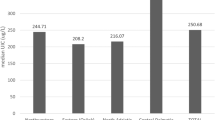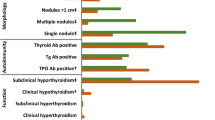Abstract
Background/objectives
Iodine deficiency disorders are estimated to affect 25% of all school-age children around the world. Current policies concerning iodine deficiency disorders in many countries are not based on robust or recent national data. Our objective was to evaluate the current status of iodine nutrition in Guinea-Bissau (West Africa).
Subject/methods
A cross-sectional survey including 299 school-age children, aged 6–14 years old, from four distinct regions of Guinea-Bissau across a coast-hinterland gradient (Bolama, Bissau, Cambaju-Bafatá, and Gabú) was performed. Several iodine deficiency disorders indicators were used: total goiter rate, median urinary iodine concentration (UIC) and regional iodine content in household salt and drinking water samples. Data on the total goiter rate were obtained by thyroid ultrasound.
Results
Goiter was found in 73.5% (CI 95%, 68.5–78.2%) of the school-age children. We observed a median urinary iodine concentration of 110 mcg/l, with 7.3% of the studied population presenting urinary iodine concentration < 50 mcg/l. Only 12.5% of the household salt samples revealed iodine content ≥ 15 mg/kg. Median well water iodine concentration was 11.7 mcg/l.
Conclusions
Guinea-Bissau presents high rates of goiter in school-age children despite satisfactory median urinary iodine concentration population levels. Salt and drinking water iodine median content cannot explain these findings. Further studies following the progress in iodine deficiency status and the presence of potential goitrogens in diet of this vulnerable population are in needed.
This is a preview of subscription content, access via your institution
Access options
Subscribe to this journal
Receive 12 print issues and online access
$259.00 per year
only $21.58 per issue
Buy this article
- Purchase on Springer Link
- Instant access to full article PDF
Prices may be subject to local taxes which are calculated during checkout


Similar content being viewed by others
References
ZimmermannMB, BoelaertK.Iodine deficiency and thyroid disorders.Lancet Diabetes Endocrinol. 2015;3:286–295.
Zimmermann MB. Iodine deficiency and excess in children: worldwide status in 2013. Endocr Pract. 2013;19:839–846.
WHO, UNICEF, ICCIDD. Assessment of iodine deficiency disorders and monitoring their elimination: a guide for programme managers. Geneva: WHO; 2007.
Konde M, Ingenbleek Y, Daffe M, Sylla B, Barry O, Diallo S. Goitrous endemic in Guinea. Lancet. 1994;344:1675–1678.
Smyth PP, Darke C, Parkes AB, Smith DF, John R, Hetherton AM, et al. Assessment of goiter in an area of endemic iodine deficiency. Thyroid. 1999;9:895–901.
Costa FO. Bócio endémico na guiné portuguesa [Endemic goitre in Portuguese-Guinea]. Bol Cult da Guiné Port. 1954;34:243–81.
Oliveira AL, Batista JL, Silva AP, Sobrinho LG, Rocha LC. Endemic goitre in Guinea-Bissau. Bull World Health Organ. 1991;69:347–8.
Doh A. Rapport d’enquête nationale sur les manifestations de la carence em iode en Guinée-Bissau [Report of the national iodine deficiency survey in Guinea-Bissau]. Organisation de coordenation et de coopération pour la lutte contre les grandes endémies, Centre régional de recherches en alimentation et nutrition, Lome-Togo, 1995.
International Council for Control of Iodine Deficiency Disorders (ICCIDD). Major push for iodized salt planned for Guinea-Bissau in 2008. IDD Newsletter (February) 2008.
Andersen SKJ, Laurberg P. Variations in iodine excretion in healthy individuals. In: Elsevier (ed.) Comprehensive handbook of iodine, 2009.
Pino S, Fang SL, Braverman LE. Ammonium persulfate: a safe alternative oxidizing reagent for measuring urinary iodine. Clin Chem. 1996;42:239–43.
Centers for Disease Control and Prevention; EQUIP: Ensuring the Quality of Urinary Iodine Procedures. In. https://www.cdc.gov/labstandards/equip.html, 2017.
Sullivan KM, Houston R, Cervinskas J, Gorstein J. Monitoring universal salt iodization programs. World Health Organization. Ottawa: Micronutrient Initiative; 1995.
Greenberg AECL, Eaton AD (eds). Standard Methods for the Examination of Water and Wastewater. Washington, DC, USA: American Public Health Association; 1992.
Brunn J, Block U, Ruf G, Bos I, Kunze WP, Scriba PC. Volumetric analysis of thyroid lobes by real-time ultrasound (author’s transl). Dtsch Med Wochenschr. 1981;106:1338–1340.
Zimmermann MB, Hess SY, Molinari L, De Benoist B, Delange F, Braverman LE, et al. New reference values for thyroid volume by ultrasound in iodine-sufficient schoolchildren: a world health organization/nutrition for health and development iodine deficiency study group report. Am J Clin Nutr. 2004;79:231–237.
Organization WH Physical status: The use and interpretation of anthropometry. Report of a WHO expert committee. WHO 1995; vol. Technical Report Series 854 Geneva.
de Onis M, Onyango AW, Borghi E, Siyam A, Nishida C, Siekmann J, Development of a WHO growth reference for school-aged children and adolescents. Bull World Health Organ. 2007;85:660–667.
Zimmermann MB, Andersson M, Assessment of iodine nutrition in populations: past, present, and future. Nutr Rev. 2012;70:553–570.
Henjum S, Barikmo I, Gjerlaug AK, Mohamed-Lehabib A, Oshaug A, Strand TA, et al. Endemic goitre and excessive iodine in urine and drinking water among Saharawi refugee children. Public Health Nutr. 2010;13:1472–1477.
Brahmbhatt SR, Brahmbhatt RM, Boyages SC, Impact of protein energy malnutrition on thyroid size in an iodine deficient population of Gujarat (India): Is it an aetiological factor for goiter?. Eur J Endocrinol. 2001;145:11–17.
Zimmermann MB, Molinari L, Spehl M, Weidinger-Toth J, Podoba J, Hess S, et al. Toward a consensus on reference values for thyroid volume in iodine-replete schoolchildren: results of a workshop on inter-observer and inter-equipment variation in sonographic measurement of thyroid volume. Eur J Endocrinol. 2001;144:213–220.
Zimmermann MB, Hess SY, Adou P, Toresanni T, Wegmuller R, Hurrell RF, Thyroid size and goiter prevalence after introduction of iodized salt: a 5-y prospective study in schoolchildren in Cote d’Ivoire. Am J Clin Nutr. 2003;77:663–667.
Moudgal NR, Srinivasan V, Sarma PS, Studies on goitrogenic agents in food. II. Goitrogenic action of arachidoside. J Nutr. 1957;61:97–101.
Zimmermann MB, Iodine deficiency. Endocr Rev. 2009;30:376–408.
Thorne CJ, Roberts LM, Edwards DR, Haque MS, Cumbassa A, Last AR, Anaemia and malnutrition in children aged 0-59 months on the Bijagos Archipelago, Guinea-Bissau, WestAfrica: a cross-sectional, population-based study. Paediatr Int Child Health. 2013;33:151–60.
Biering-Sorensen S, Fisker AB, Ravn H, Camala L, Monteiro I, Aaby P, et al. The effect of neonatal vitamin A supplementation on growth in the first year of life among low-birth-weight infants in Guinea-Bissau: two by two factorial randomised controlled trial. BMC Pediatr. 2013;13:87
Bordalo AA, Savva-Bordalo J, The quest for safe drinking water: an example from Guinea-Bissau (West Africa). Water Res. 2007;41:2978–2986.
Gaitan E, Goitrogens in food and water. Annu Rev Nutr. 1990;10:21–39.
Republique de Guinée, Ministere de la Santé Publique. Rapport de l'evaluation de la lutte contre les TDCI en Guinée [Report of the evaluation of the fight against IDD in Guinea]. Conakry, Guinée, Republique de Guinée, Ministere de la Santé Publique, 2003.
Fiorentino M, Bastard G, Sembene M, Fortin S, Traissac P, Landais E, et al. Anthropometric and micronutrient status of school-children in an urban west Africa setting: a cross-sectional study in dakar (senegal). PloS ONE. 2013;8:e84328
World Health Organization I, UNICEF. Recommended iodine levels in salt and guidelines for monitoring their adequacy and effectiveness. World Health Organization 1996; WHO/NUT/96.13.
Organization WH Guideline: Fortification of Food-Grade Salt with Iodine for the Prevention and Control of Iodine Deficiency Disorders. World Health Organization 2014.
UNICEF. Guinea-Bissau Multiple. Indicator Cluster Survey 2010. In. http://data.unicef.org/nutrition/iodine.html, 2010.
Cherinet A, Kelbessa U, Determinants of iodine deficiency in school children in different regions of Ethiopia. East Afr Med J. 2000;77:133–7.
Fuge R, Johnson CC, The geochemistry of iodine - a review. Environ Geochem Health. 1986;8:31–54.
Pedersen KM, Laurberg P, Nohr S, Jorgensen A, Andersen S. Iodine in drinking water varies by more than 100-fold in Denmark. Importance for iodine content of infant formulas. Eur J Endocrinol. 1999;140:400–403.
Olife IC, Okaka AN, Dioka CE, Meludu SC, Orisakwe OE. Iodine status and the effect of soil erosion on trace elements in Nanka and Oba towns of Anambra State, Nigeria. Ann Chim. 2007;97:895–903.
Bourdoux P, Delange F, Gerard M, Mafuta M, Hanson A, Ermans AM, Evidence that cassava ingestion increases thiocyanate formation: a possible etiologic factor in endemic goiter. J Clin Endocrinol Metab. 1978;46:613–621.
Lazarus JH, Parkes AB, John R, N’Diaye M, Prysor-Jones SG. Endemic goitre in Senegal-thyroid function etiological factors and treatment with oral iodized oil. Acta Endocrinol. 1992;126:149–154.
Henjum S, Strand TA, Torheim LE, Oshaug A, Parr CL. Data quality and practical challenges of thyroid volume assessment by ultrasound under field conditions - observer errors may affect prevalence estimates of goitre. Nutr J. 2010;9:66
Furnee CA, West CE, van Der Haar F, Hautvast JG. Efficacy of oral iodised oil is associated with anthropometric status in severely iodine-deficient schoolchildren in rural Malawi. Br J Nutr. 2000;84:345–352.
Spohrer R, Knowles J, Jallier V, Ndiaye B, Indorf C, Guinot P, et al. Estimation of population iodine intake from iodized salt consumed through bouillon seasoning in Senegal. Ann N Y Acad Sci. 2015;1357:43–52.
Acknowledgements
We wish to thank all children and families who agreed to participate in this study; Alfucene Dabo and Víctor Madrigal from Ayuda, Intercambio y Desarollo (AIDA), Bissau—Guinea-Bissau, for the logistic support; Professor Joana Palha from the Life and Health Sciences Research Institute (ICVS), University of Minho, Braga—Portugal, for the portable US; and to Hugo Ribeiro for his technical support with the screening of urine samples.
Author information
Authors and Affiliations
Corresponding author
Ethics declarations
Compliance with ethical standards
This study was conducted according to the guidelines laid down in the Declaration of Helsinki and all procedures involving human subjects were approved by the ICBAS-University of Porto. Verbal informed consent was obtained from all subjects or guardians. Verbal consent was witnessed and formally recorded.
Conflict of interest
The authors declare that they have no conflict of interest.
Additional information
A poster with part of this work was presented at the 36th Annual Meeting of the European Thyroid Association, Pisa, Italy in September 2012 and published as an abstract in the Eur Thyroid J 2012;1(suppl 1):75–208.
Rights and permissions
About this article
Cite this article
Carvalho, A.C., Machado, A., Embalo, A.R. et al. Endemic goiter and iodine deficiency status among Guinea-Bissau school-age children. Eur J Clin Nutr 72, 1576–1582 (2018). https://doi.org/10.1038/s41430-017-0055-0
Received:
Revised:
Accepted:
Published:
Issue Date:
DOI: https://doi.org/10.1038/s41430-017-0055-0
This article is cited by
-
The relationship of different levels of high iodine and goiter in school children: a meta-analysis
Nutrition & Metabolism (2021)



